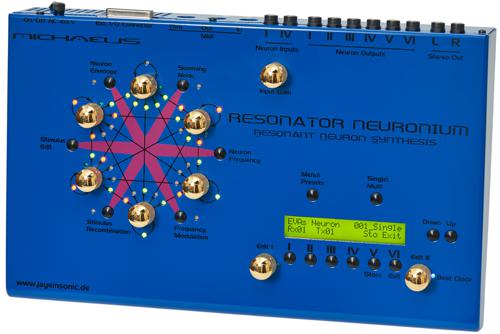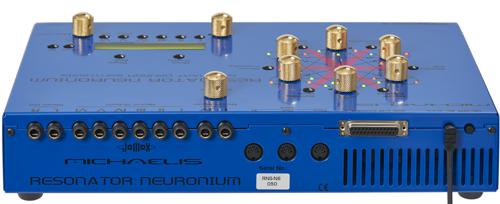|
There is again a limited edition of the Resonator Neuronium available!
Available now:
https://www.jomox.de/shop/product_details.php?lang=en&cur=1&product_id=4&category_id=&all=3&product=resonator-neuronium
The Resonator Neuronium has got a stable OS 2.0 with an uncrashable BIOS. The Midi CC performance has been improved a lot.
######################################################################
+++ATTENTION ATTENTION ATTENTION!+++
To all owners of an OLD version 1.xx Resonator Neuronium:
PLEASE DO NOT, UNDER ANY CIRCUMSTANCES, try to update the old RN with the
OS Sysex Dump 2.x!!!
This would destroy the old OS and results in a machine that won't boot any more. Then only a repair can help.
For OS 2.x, the RN needs a hardware upgrade that includes the exchange for many chips inside. It's not for free, please contact me if you are interested!
######################################################################
This is the first realisation of a device with Resonant Neuron Synthesis, called the "Resonator Neuronium".
The new paradigmas of the 21 century are called complexity, order from chaos, self organisation of complex systems, networking and cooperation. From a certain complexity onwards a system is not even the sum total of its parts but a greater whole which shows totally new attributes than its sub structures.
The Resonator Neuronium has 6 analog resonant neurons. The net parameters can be programmed by the lefthand structure in form of a hexagon by use of knobs, buttons and LEDs.

We have 6 neurons with 6x6 = 36 net connections for one parameter. In order that summation and FM is connected, we have 2x36 = 72 net connections with individual pots for each node.
Net Programming
The rotary knobs are touch-sensitive and allow the net links by a simple touch of the metal coated knobs. The intensities of "wi" or amounts are then displayed and edited by turning the respective knob of the receiving neuron. For better understanding, the routed net connection is displayed as a matrix-LED and displayed in the LCD as Tx (transmitter) -> Rx (receiver) value. If you have a summing net connection, LEDs light up green, with FM connections LEDs light up red.
The loops indicate the self-networking connection of a neuron. As described in the article, one can let the neuron become self oscillating by resonance or let it vibrate with positive feedback dependent of the sign of the loop value.

The menu selection is made by the buttons within the hexagon to let the user not unnessecarily step through awkward menus. The menus are:
Summing Node
summing input node of the neuron
Neuron Frequency
basic frequency of the resonant neuron = cutoff
Frequency Modulation
frequency modulation input of the neuron
Stimulus Recombination
Recombination of wave segments (DNA) of the stimulus with other neuron's DNA by mating of the DNA
Stimulus Edit
Alteration (editing) of wave forms (DNA) of the stimulus of a neuron. Input by knobs at the LCD display.
Neuron Envelope
VCA envelope of each neuron with ADSR. Each neuron is led through an ADSR envelope which time-slices the signal and lets it being played from a midi keyboard.
Display/Menu
On the right side there is a 24 character LCD display placed with 6 soft buttons and 2 knobs. The pots at the display are used for different tasks, e.g. input of DNA waveform of the stimulus of a selected neuron. In the menu selection there are different things to be programmed, like e.g. the midi channel, multi mode (ranking of different channels to different neurons), VCA envelopes of the neurons and more. The rest of the keys is used for selection of the preset memory and the switching between main menu and edit menu.
All analog neurons in- and outputs are lead out through a 25 pin D-SUB connector at the console back. By this you can cascade 2 or more Resonators to a greater network.

In/Outputs
Two audio inputs are available who feed neuron 1 and 4. Thus you can use any kind of external signal to excite the network. So the Resonator becomes a tool for sound processing as well as a sound production instrument.
Each neuron has an own last stage VCA envelope with its own output. It is imagineable to let the outputs drive 6 single speakers in a room to form a sonic image installation; a sourround 5.1 application could be possible as well.
The 6 neurons with individual VCA envelopes get mixed again to a stereo mix with an additional VCA envelope. They are sent to the stereo outputs L=left and R=right. The odd neurons are sent to the left, the even ones to the right stereo channel.
Midi
At the back side there is the well-known midi trio to trigger the neuron envelopes and stimuli by an external keyboard or sequencer. Also certain CC controllers can be sent or received for parameter changes and neuron interactions.
© Michaelis Hardwaredesign 2000-2017
|